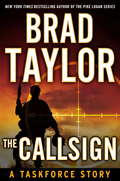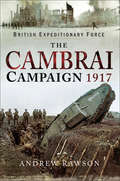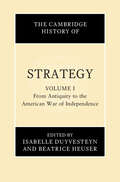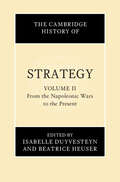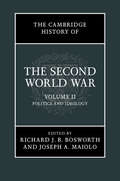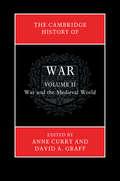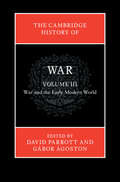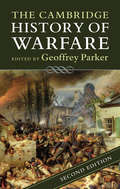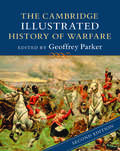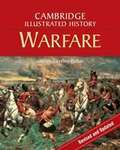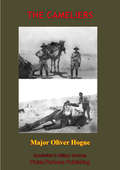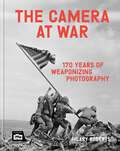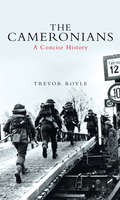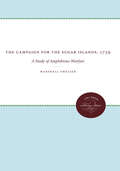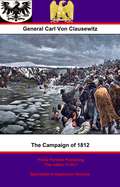- Table View
- List View
The Callsign: A Taskforce Story, Featuring an Excerpt from The Forgotten Soldier
by Brad TaylorIn the first ever short story by Retired Delta Force officer Brad Taylor, the stakes couldn't be higher as operator Pike Logan goes after the first Taskforce target leading a team he can't fully trust. Includes an excerpt of Brad Taylor's latest Pike Logan novel, The Forgotten Soldier, on sale 12/29/2015. Commissioned at the highest level of the U.S. government, and designed to operate outside the bounds of U.S. law, a new counter-terrorist unit known as the Taskforce has just been formed, but not fully tested. Until now. Pike Logan has been given a team of operators drawn from the CIA's National Clandestine Service and the military's Special Operations Forces without any say in selecting the men on which he must depend. While executing a full mission profile exercise on U.S. soil, a target of opportunity appears before the Taskforce is deemed mission capable. Forced to execute, Pike and his team are sent to Yemen to track their first real target. The future of the Taskforce depends on their success, but when Pike is challenged by one of his own, their clear-cut mission teeters on the brink of disaster. The price of failure will reverberate much deeper than the loss of the target - straight into the presidency itself.Propulsive, compelling, and told with unparalleled realism, The Callsign brings readers new insight into the origins of the Taskforce as they execute the first Omega operation in a relentless and action-packed short story.
The Cambrai Campaign, 1917 (British Expeditionary Force)
by Andrew RawsonCambrai Campaign 1917 is an account of the British Expeditionary Forces battles in November and December of 1917. It starts with the plan to carry out a tank raid on the Hindenburg Line at Cambrai. The raid grew into a full scale attack and Third Army would rely on a different style of attack. The preliminary bombardment would be done away with and the troops would assemble in secret.Predicted fire had reached such a level of accuracy that 1,000 guns could hit targets without registration. Meanwhile, over 375 tanks would lead the infantry through the Hindenburg Line, ripping holes in the wire and suppressing the enemy. The study of the German counterattack ten days later, illustrates the different tactics they used and the British experience on the defensive.Each stage of the battle is given equal treatment, with detailed insights into the most talked about side of the campaign, the British side. It explains how far the Tank Corps had come in changing the face of trench warfare. Over forty new maps chart the day by day progress of each corps on each day.Together the narrative and the maps provide an insight into the British Armys experience during this important campaign. The men who made a difference are mentioned; those who led the advances, those who stopped the counterattacks and those who were awarded the Victoria Cross.Discover the Cambrai campaign and learn how the British Armys brave soldiers fought and died fighting to achieve their objectives.
The Cambridge History of Strategy: Volume 1, From Antiquity to the American War of Independence (The Cambridge History of Strategy)
by Beatrice Heuser Isabelle DuyvesteynVolume I of The Cambridge History of Strategy offers a history of the practice of strategy from the beginning of recorded history, to the late eighteenth century, from all parts of the world. Drawing on material evidence covering two and a half millennia, an international team of leading scholars in each subject examines how strategy was formulated and applied and with what tools, from ancient Greece and China to the Ottoman and Mughal Empires and the American Revolutionary War. They explore key themes from decision-makers and strategy-making processes, causes of wars and war aims and tools of strategy in war and peace, to configurations of armed forces and distinctive and shared ways of war across civilisations and periods. A comparative conclusion examines how the linking of political goals with military means took place in different parts of the world over the course of history, asking whether strategic practice has universal features.
The Cambridge History of Strategy: Volume 2, From the Napoleonic Wars to the Present (The Cambridge History of Strategy)
by Beatrice Heuser Isabelle DuyvesteynVolume II of The Cambridge History of Strategy focuses on the practice of strategy from 1800 to the present day. A team of eminent scholars examine how leaders of states, empires and non-state groups (such as guerrilla forces, rebel groups and terrorists) have attempted to practise strategy in the modern period. With a focus on the actual 'doing' of strategy, the volume aims to understand real-world experiences when ideas about conflict are carried out against a responding and proactive opponent. The case studies and material presented in the volume form an invitation to rethink dominant perspectives in the field of strategic studies. As the case studies demonstrate, strategy is most often not a stylised, premeditated and wilful phenomenon. Rather, it is a product of circumstance and opportunity, both structural and agential, leading to a view of strategy as an ad hoc, if not chaotic, enterprise.
The Cambridge History of The Second World War: Economy, Society and Culture
by Adam Tooze Michael Geyer Geyer, Michael and Tooze, AdamThe conflict that ended in 1945 is often described as a 'total war', unprecedented in both scale and character. Volume 3 of The Cambridge History of the Second World War adopts a transnational approach to offer a comprehensive and global analysis of the war as an economic, social and cultural event. Across twenty-eight chapters and four key parts, the volume addresses complex themes such as the political economy of industrial war, the social practices of war, the moral economy of war and peace and the repercussions of catastrophic destruction. A team of nearly thirty leading historians together show how entire nations mobilized their economies and populations in the face of unimaginable violence, and how they dealt with the subsequent losses that followed. The volume concludes by considering the lasting impact of the conflict and the memory of war across different cultures of commemoration.
The Cambridge History of The Second World War: Politics and Ideology (The\cambridge History Of The Second World War Ser.)
by Joseph A. Bosworth Joseph A. Maiolo Richard J. B. MaioloWar is often described as an extension of politics by violent means. With contributions from twenty-five eminent historians, Volume 2 of The Cambridge History of the Second World War examines the relationship between ideology and politics in the war's origins, dynamics and consequences. Part I examines the ideologies of the combatants and shows how the war can be understood as a struggle of words, ideas and values with the rival powers expressing divergent claims to justice and controlling news from the front in order to sustain moral and influence international opinion. Part II looks at politics from the perspective of pre-war and wartime diplomacy as well as examining the way in which neutrals were treated and behaved. The volume concludes by assessing the impact of states, politics and ideology on the fate of individuals as occupied and liberated peoples, collaborators and resistors, and as British and French colonial subjects.
The Cambridge History of War
by Hans Van de Ven Dennis Showalter Roger Chickering Roger Chickering Dennis ShowalterVolume IV of The Cambridge History of War offers a definitive new account of war in the most destructive period in human history. Opening with the massive conflicts that erupted in the mid-nineteenth century in the US, Asia and Europe, leading historians trace the global evolution of warfare through 'the age of mass', 'the age of machine', and 'the age of management'. They explore how industrialization and nationalism fostered vast armies whilst the emergence of mobile warfare and improved communications systems made possible the 'total warfare' of the two World Wars. With military conflict regionalized after 1945 they show how guerrilla and asymmetrical warfare highlighted the limits of the machine and mass as well as the importance of the media in winning 'hearts and minds'. This is a comprehensive guide to every facet of modern war from strategy and operations to its social, cultural, technological and political contexts and legacies.
The Cambridge History of War: Volume 2, War and the Medieval World (Cambridge History of War)
by David A. GraffVolume II of The Cambridge History of War covers what in Europe is commonly called 'the Middle Ages'. It includes all of the well-known themes of European warfare, from the migrations of the Germanic peoples and the Vikings through the Reconquista, the Crusades and the age of chivalry, to the development of state-controlled gunpowder-wielding armies and the urban militias of the later middle ages; yet its scope is world-wide, ranging across Eurasia and the Americas to trace the interregional connections formed by the great Arab conquests and the expansion of Islam, the migrations of horse nomads such as the Avars and the Turks, the formation of the vast Mongol Empire, and the spread of new technologies – including gunpowder and the earliest firearms – by land and sea.
The Cambridge History of War: Volume 3, War and the Early Modern World (Cambridge History of War)
by David Parrott Gábor ÁgostonVolume III of The Cambridge History of War covers the early modern world, offering a four-hundred-year perspective from the last Eurasian nomadic empires to the advent of ironclad, steam-driven warships in the mid-nineteenth century. Together, the chapters cover the rise of professional armies and purpose-built warships in Europe; the evolution of military societies in the great Islamic empires; the vicissitudes of Ming and Qing military organization and that of their Asian neighbours; and the raising and maintaining of armies in Africa and the Americas. Numerous processes of imperial expansion, both on land of sea, are examined, as are the processes of global confrontation and interchange across different military systems. Technology, organization, finance, and military cultures are each explored from a broad perspective. Bringing together an impressive team of experts in their fields, the volume provides a comprehensive and accessible history of war from 1450–1850.
The Cambridge History of Warfare (Cambridge Illustrated Histories Ser.)
by Geoffrey ParkerThe new edition of The Cambridge History of Warfare, written and updated by a team of eight distinguished military historians, examines how war was waged by Western powers across a sweeping timeframe beginning with classical Greece and Rome, moving through the Middle Ages and the early modern period, down to the wars of the twenty-first century in Afghanistan, Iraq, and Syria. The book stresses five essential aspects of the Western way of war: a combination of technology, discipline, and an aggressive military tradition with an extraordinary capacity to respond rapidly to challenges and to use capital rather than manpower to win. Although the focus remains on the West, and on the role of violence in its rise, each chapter also examines the military effectiveness of its adversaries and the regions in which the West's military edge has been – and continues to be – challenged.
The Cambridge History of the First World War: Volume 1
by Jay WinterVolume 1 of The Cambridge History of the First World War offers a history of the war from a predominantly political angle and concerns itself with the story of the state at war. It explores the multifaceted history of state power and highlights the ways in which different political systems responded to, and were deformed by, the near-unbearable pressures of war. Every state involved faced issues of military-civilian relations, parliamentary reviews of military policy, and the growth of war economies; and yet their particular form and significance varied in each national case. Written by a global team of historical experts, this volume sets new standards in the political history of the waging of war in an authoritative new narrative, which addresses problems of logistics, morale, innovation in tactics and weapons systems, and the use and abuse of science; all of which were ubiquitous during the conflict.
The Cambridge History of the First World War: Volume 2
by Jay WinterVolume 2 of The Cambridge History of the First World War offers a history of the war from a predominantly political angle and concerns itself with the story of the state at war. It explores the multifaceted history of state power and highlights the ways in which different political systems responded to, and were deformed by, the near-unbearable pressures of war. Every state involved faced issues of military-civilian relations, parliamentary reviews of military policy, and the growth of war economies; and yet their particular form and significance varied in each national case. Written by a global team of historical experts, this volume sets new standards in the political history of the waging of war in an authoritative new narrative, which addresses problems of logistics, morale, innovation in tactics and weapons systems, and the use and abuse of science; all of which were ubiquitous during the conflict.
The Cambridge History of the First World War: Volume 3
by Jay WinterThis third volume of The Cambridge History of the First World War provides a comprehensive account of the war's military history. An international team of leading historians chart how a war made possible by globalization and imperial expansion unfolded into catastrophe, growing year by year in scale and destructive power far beyond what anyone had anticipated in 1914. Adopting a global perspective, the volume analyses the spatial impact of the war and the subsequent ripple effects that occurred both regionally and across the world. It explores how imperial powers devoted vast reserves of manpower and material to their war efforts, and how, by doing so, they changed the political landscape of the world order. It also charts the moral, political and legal implications of the changing character of war and, in particular, the collapse of the distinction between civilian and military targets.
The Cambridge History of the Second World War: Fighting the War
by John Ferris Evan Mawdsley Ferris, John and Mawdsley, EvanThe military events of the Second World War have been the subject of historical debate from 1945 to the present. It mattered greatly who won, and fighting was the essential determinant of victory or defeat. In Volume 1 of The Cambridge History of the Second World War a team of twenty-five leading historians offer a comprehensive and authoritative new account of the war's military and strategic history. Part I examines the military cultures and strategic objectives of the eight major powers involved. Part II surveys the course of the war in its key theatres across the world, and assesses why one side or the other prevailed there. Part III considers, in a comparative way, key aspects of military activity, including planning, intelligence, and organisation of troops and matérial, as well as guerrilla fighting and treatment of prisoners of war.
The Cambridge Illustrated History of Warfare (Cambridge Illustrated Histories)
by Geoffrey ParkerThe new edition of The Cambridge Illustrated History of Warfare, written and updated by a team of nine distinguished military historians, examines how war was waged by Western powers across a sweeping timeframe, beginning with classical Greece and Rome, moving through the Middle Ages and the early modern period, down to the wars of the twenty-first century in Afghanistan, Iraq, and Syria. The book stresses five essential aspects of the Western way of war: a combination of technology, discipline, and an aggressive military tradition with an extraordinary capacity to respond rapidly to challenges and to use capital rather than manpower to win. Although the focus remains on the West, and on the role of violence in its rise, each chapter also examines the military effectiveness of its adversaries and the regions in which the West's military edge has been - and continues to be - challenged.
The Cambridge Illustrated History of Warfare: The Triumph of the West Revised and Updated (Cambridge Illustrated Histories)
by Geoffrey ParkerNow available in a revised and updated version, The Cambridge Illustrated History of Warfare provides a unique account of Western warfare from antiquity to the present day. The book treats the history of all aspects of the subject: the development of warfare on land, sea and air; weapons and technology; strategy and defense; discipline and intelligence; mercenaries and standing armies; cavalry and infantry; chivalry and Blitzkrieg; guerilla assault and nuclear arsenals. It places in context particular key events in the history of armed engagement, from the Greek victory at Marathon, through the introduction of gunpowder in medieval England and France, to the jungle warfare of Vietnam and the strategic air attacks of the Gulf War. Throughout, there is an emphasis on the socio-economic aspects of military progress: who pays for it, how can its returns be measured, and to what extent does it explain the rise of the West to global dominance over two millennia?
The Cameliers
by Major Oliver Hogue"Oliver Hogue (1880-1919), journalist and soldier, was born on 29 April 1880 in Sydney ...He enlisted in the Australian Imperial Force in Sep. 1914 as a trooper with the 6th Light Horse Regiment. Commissioned second lieutenant in Nov., he sailed for Egypt with the 2nd L.H. Brigade in the Suevic in Dec..Hogue served on Gallipoli with the Light Horse (dismounted) for five months, then was invalided to England with enteric fever. In May 1915 he was promoted lieutenant and appointed orderly officer to Colonel Ryrie, the brigade commander. As 'Trooper Bluegum' he wrote articles for the Herald subsequently collected in the books Love Letters of an Anzac and Trooper Bluegum at the Dardanelles. Sometimes representing war as almost a sport, he took pride in seeing 'the way our young Australians played the game of war'.Hogue returned from hospital in England to the 6th L.H. in Sinai and fought in the decisive battle of Romani. Transferred to the Imperial Camel Corps on 1 Nov. 1916, he was promoted captain on 3 July 1917. He fought with the Camel Corps at Magdhaba, Rafa, Gaza, Tel el Khuweilfe, Musallabeh, and was with them in the first trans-Jordan raid to Amman. In 1917 Hogue led the 'Pilgrim's Patrol' of fifty Cameliers and two machine-guns into the Sinai desert to Jebel Mousa, to collect Turkish rifles from the thousands of Bedouins in the desert.After the summer of 1918, spent in the Jordan Valley, camels were no longer required. The Cameliers were given horses and swords and converted into cavalry. Hogue, promoted major on 1 July 1918, was now in Brigadier General George Macarthur-Onslow's 5th L.H. Brigade, commanding a squadron of the 14th L.H. Regiment. At the taking of Damascus by the Desert Mounted Corps in Sep. 1918, the 5th Brigade stopped the Turkish Army escaping through the Barada Gorge. As well as the articles sent to Australia, and some in English magazines, Hogue wrote a third book, The Cameliers,..."-Aust. Dict. of Nat. Bio.
The Camera at War: 170 years of weaponizing photography
by Hilary RobertsIt is said that the first casualty of war is truth. But in the arena of war photography, the truth is never simple.Drawing on an incredible range of imagery from the Imperial War Museum's vast collection and other major archives around the globe, expert curator Hilary Roberts presents a new perspective on the role of image manipulation in this field over the past 170 years,exploring the consequences for our understanding of historic and contemporary conflicts. From the staged scenes and hand-coloured Daguerreotypes of the Crimean War at the very beginning of conflict photography to the AI-generated protest and propaganda imagery of today, Roberts explores the myriad ways in which layers of meaning can be added, erased or changed completely. As The Camera at War so powerfully reveals, sometimes this has been done in order to present a closer approximation of the truth, and sometimes for the causes of national morale, subterfuge and control of the winning narrative.
The Cameronians: A Concise History
by Trevor RoyleIn May 1968, as part of cutbacks to the British Army, The Cameronians (Scottish Rifles) was disbanded at a moving ceremony held at the same spot in Douglas in Lanarkshire at which it had been raised in 1689. And yet, although the regiment is no more, its place in history is unassailable. The ceremony embraced the history of one regiment, The Cameronians, which had its origins in the turbulent period that accompanied the rise of the House of Orange at the end of the seventeenth century, while its other component part - the 90th (Perthshire Light Infantry) - was raised as a light infantry regiment during the war against Revolutionary France.Following amalgamation in 1881, The Cameronians (Scottish Rifles) quickly built up a solid reputation as a fighting regiment. During the First World War it raised 27 battalions and during the Second World War its battalions served in Europe and Burma. In the course of its long history, the regiment provided the British Army with many distinguished soldiers including three field marshals: Viscounts Hill and Wolseley and Sir Evelyn Wood.Always tough and enduring in battle, it reflected the character of its main recruitment area - Glasgow and Lanarkshire - and in later years it took self-conscious pride when the Germans nicknamed its soldiers Giftzwerge, or poison dwarfs. The Cameronians puts its story into the context of British military history and makes use of personal testimony to reveal the life of the regiment.
The Campaign for the Sugar Islands, 1759: A Study of Amphibious Warfare (Published by the Omohundro Institute of Early American History and Culture and the University of North Carolina Press)
by Marshall SmelserIn the battle for empire that was the Seven Years' War, France's Sugar Islands, Guadeloupe and Martinique, were stakes as important as the Dominion of Canada. This book sketches the background strategy that led William Pitt to send an expedition to capture them, but it is chiefly the story of the campaign itself.Originally published in 1955.A UNC Press Enduring Edition -- UNC Press Enduring Editions use the latest in digital technology to make available again books from our distinguished backlist that were previously out of print. These editions are published unaltered from the original, and are presented in affordable paperback formats, bringing readers both historical and cultural value.
The Campaign of 1812
by General Carl Philipp Gottfried von Clausewitz Francis Egerton, 1st Earl of EllesmereThis ebook is purpose built and is proof-read and re-type set from the original to provide an outstanding experience of reflowing text for an ebook reader. Carl von Clausewitz needs little introduction. A Prussian soldier of distinction during the Napoleonic Wars, he served in 1806 during the disastrous Jena campaign, which led to dismemberment and occupation of his homeland. He later transferred to the Russian service in 1812 and, like many of his fellow Prussian officers, participated in the campaign that broke the Grande Armée. After further service in Prussian ranks during 1814 and 1815, he took over as head of the Prussian Staff College, or Kriegsakademie, and began writing his monumental work on the theory of conflict. The first three volumes of his posthumous publication was Vom Kriege, which has become hugely famous and is known under the title "On War" in English. The other volumes mainly formed discussion and critique of the recent campaigns against the French forces, such as Napoleon's Italian campaign in 1796, and also those that Clausewitz took part in, such as the 1812 campaign in Russia. "The Campaign of 1812" is the translation of his experiences whilst serving in the Russian ranks throughout 1812, as the hordes of French and allied troops invaded. He combines his own recollections with criticism on the characters and decisions of the Generals around him; this can sometimes be rather cutting and scathing toward Generals who were directing the Russian war effort. He also dissects the movement of the French forces and gives ample reasoning for the disastrous outcome of the campaign, attributing a great part of it to the faulty plans and insufficient forethought of Napoleon. A brilliant excerpt of the writings of an acknowledged military genius of great penetration and insight. Text taken, whole and complete from the 1843 edition, John Murray, London. Original -260 pages Author - General Carl Philipp Gottfried von Clausewitz - (1780 - 1831) Translator - Francis Egerton, 1st Earl of Ellesmere (1800-1857) Illustrations - 1 Map not reproduced due to its size. Linked TOC.
The Campaign of MDCCCXV: or, A Narrative of the Military Operations Which Took Place in France and Belgium During the Hundred Days
by Gen. Baron Gaspard Gourgaud“THE Emperor Napoleon having been pleased to communicate to me his opinion on the principal events of the Campaign of MDCCCXV, I have, in writing the following Narrative, availed myself of that favourable circumstance, and also of my own recollections of the great catastrophe, of which I was an eyewitness.“I have read a great number of publications on the same subject, since I returned to Europe; but most of the authors appear to have been governed by anger or animosity, and others to have been blinded by overweening national partialities: few have studied to give a true picture of the events as they occurred.“Error often repeated assumes at last the appearance of reality; but being in this instance possessed of the means of removing it, I feel that a longer silence on my part would be inexcusable. No other reason could have overcome my repugnance to expose myself to literary criticism.“Writing as a military man, I have only alluded to political events in order to explain how it happened, that a single battle sufficed to subjugate the French nation, governed by the first Captain of modern times. It is not for me to attempt to discuss these great questions:—Has the battle of Waterloo consolidated or shaken every throne?—Has it secured the tranquillity of Europe or undermined all its foundations? Time will determine.“The Public will find in this Work a simple but faithful recital of facts; the military reader, the information necessary to enable him to estimate the faults which were committed, and the talents which were unfolded; the French, a new proof, that, notwithstanding their misfortunes, their warlike reputation was not tarnished in the field of Waterloo.” (Gaspard Gourgaud)Illustrated with a Map of the principal Theatre of War.
The Campaign of Marengo, with Comments.
by Herbert H. SergeantThis ebook is purpose built and is proof-read and re-type set from the original to provide an outstanding experience of reflowing text for an ebook reader. The situation in 1800 was not auspicious for the new born French Republic, Napoleon Bonaparte, as he then was, had with some aid from his family, fellow army officers and politicians, overthrown the venal and corrupt Directory. However France was menaced on its German borders by a vast Austrian army and a further large Austrian army bearing down on the Var and Nice in Northern Italy. Most of the gains won by Bonaparte in his first campaign ending in the triumphant battle of Rivoli had been lost, Switzerland had only just been saved by a masterful campaign by Masséna. Bonaparte attacked the problem with energy, activity and genius, although not secure on a throne he had to balance the ego of his main military rival Moreau, he embarked on a risky gamble to take an army across the Alps and shatter the Austrians in Italy. Herbert Sargent's book follows Bonaparte's first campaign as First Consul of the French Republic as he drives, organizes and masterminds his very own blitzkreig across the Alps. As a serving officer in the American Army, who saw active service in a number of the late 19th and early 20th Century campaigns of the United States, he is well qualified to pass his opinion on Napoleon's brilliant campaign. It would be this campaign that would be the bedrock for the political machinations that would see Napoleon crowned as Emperor of the French some four years later. A classic account of a campaign not much covered in Napoleonic literature. Author - Herbert H. Sargent - (1858-1921) Text taken, whole and complete, from the edition published in 1897, Chicago, by A. C. McClurg and Company. Original - 232 pages Maps - Due to their size these have not been included.
The Campaign of Trafalgar — 1805. Vol. I. (The Campaign of Trafalgar — 1805. #1)
by Sir Llm. Julian Stafford CorbettThis ebook is purpose built and is proof-read and re-type set from the original to provide an outstanding experience of reflowing text for an ebook reader. Of the many campaigns in the long history of Britain, naval and otherwise, there have been few more momentous than the campaign in the Mediterranean in 1804-5 culminating in the battle of Trafalgar. They spawned a national hero in the figure of heroic lord Nelson, one-armed and blind in one eye, dying at the moment of his greatest victory over a more numerous enemy. However, the story of the battle, much less the campaign, was more complex than the story of one man, however great. It is this web of sailings, counter-sailings, orders, alliances, courage and genius that Corbett elucidates with his great naval knowledge and lucid text. Sir Julian Corbett wrote this most important of studies, drawing on not only his comprehensive archive material at the Royal Naval college, but also important sources from French and Spanish sources. He was a prolific author and authority on British warfare, and more particularly the naval aspects, as well as a lecturer in history to the Royal Naval College. Title - The Campaign of Trafalgar -- 1805. Vol. I. Series Name - The Campaign of Trafalgar -- 1805. Series Number --1 Author -- Sir Julian Stafford Corbett, LLM. (1854-1922) Text taken, whole and complete, from the new edition published in 1919, London, by Longmans, Green and Co. Original - xv and 389 pages. Illustrations - 5 maps and plans.
The Campaign of Trafalgar — 1805. Vol. II. (The Campaign of Trafalgar — 1805. #2)
by Sir Llm. Julian Stafford CorbettThis ebook is purpose built and is proof-read and re-type set from the original to provide an outstanding experience of reflowing text for an ebook reader. Of the many campaigns in the long history of Britain, naval and otherwise, there have been few more momentous than the campaign in the Mediterranean in 1804-5 culminating in the battle of Trafalgar. They spawned a national hero in the figure of heroic lord Nelson, one-armed and blind in one eye, dying at the moment of his greatest victory over a more numerous enemy. However, the story of the battle, much less the campaign, was more complex than the story of one man, however great. It is this web of sailings, counter-sailings, orders, alliances, courage and genius that Corbett elucidates with his great naval knowledge and lucid text. Sir Julian Corbett wrote this most important of studies, drawing on not only his comprehensive archive material at the Royal Naval college, but also important sources from French and Spanish sources. He was a prolific author and authority on British warfare, and more particularly the naval aspects, as well as a lecturer in history to the Royal Naval College. Title - The Campaign of Trafalgar -- 1805. Vol. II. Series Name - The Campaign of Trafalgar -- 1805. Series Number --2 Author -- Sir Julian Stafford Corbett, LLM. (1854-1922) Text taken, whole and complete, from the new edition published in 1919, London, by Longmans, Green and Co. Original - 523 pages. Illustrations - 8 maps and plans.
